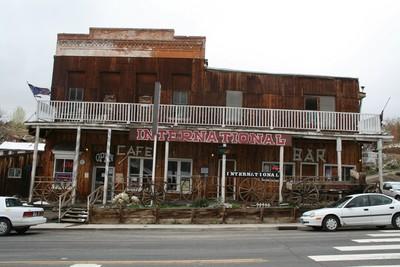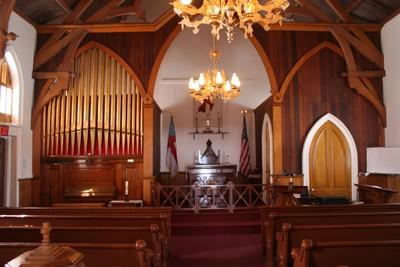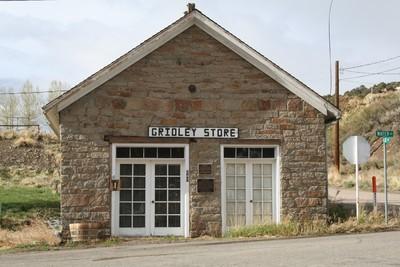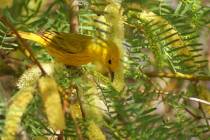History Lesson
When May's warm gaze thawed the slopes of Central Nevada, my daughter and I pointed the sport utility vehicle north to taste the authentic slice of Nevada that is Austin. We probably should have waited for the warm gaze of June, as a freak snowstorm dashed some of our outdoor-oriented plans. But we found plenty to do nevertheless.
Located in the geographic center of the state on U.S. Highway 50, also called "The Loneliest Road in America," this former boom town counts only about 300 residents today. What it lacks in size, however, it makes up in history, character and color.
Austin was put on the map after 1862 when William Talcott, an agent at a Overland Mail and Stage stop, discovered a ledge of rich silver ore in Pony Canyon, in the northern end of the Toiyabe Range. Some say he was there to gather wood, others that he was looking for a lost horse, or actually prospecting. But it really doesn't matter which is true, because the result changed this area forever.
Word spread quickly and miners and businessmen descended on the town in droves. Within a couple of years, more than 8,000 people settled here. Before the pay rock ran out, more than $50 million worth of precious metal was taken from local mines. Adjusting for inflation, that would be more than $1 billion today.
On our first morning, we took a self-guided walking tour of Austin. We found the town's small houses and buildings to be an eclectic mix of color, form and construction. The official walking tour guide, available at most businesses, maps out four historical sites and 16 historical buildings, 11 of those on the National Register of Historic Places.
We didn't do the tour in any proper order but stopped at what looked interesting along the way, including shops, the favorite attractions for my 10-year-old Charlotte. Jason's Art Gallery is owned by Duane and Jason Cooley, a father and son who not only mine their own stones locally but fashion them into silver and gold jewelry. We especially liked the stone they named Austin Blue, the color of a robin's egg.
A highlight of our tour was seeing the International Hotel, for it's not every day you see a hotel that joined a silver rush just like the miners. The original was built in Virginia City in 1859-60 but dismantled in 1863 to make room for a larger one. Some parts of the building, including the essential bar, were brought to Austin and reconstructed. Despite its antiquity, the bar and adjacent cafe are still in business. We also strolled by Nevada's oldest bank building, which is now the library, and then visited the churches.
Three of them are among the most prominent buildings in Austin. The Old Methodist and St. Augustine's Catholic churches were both built in 1866, and St. George's Episcopal in 1877-78. All three are on the National Register of Historic Places. The Methodist church currently serves as the Austin City Hall and St. Augustine's has just received a grant to restore its roof and spire structure, which marks the beginning of a long-term project. St. George's is the only one of the three that still has Sunday services. We were fortunate enough to get local resident Dee Helming to give us a personal tour.
As soon as we entered the front door of St. George's we were struck by the obvious care, workmanship and first-class materials that went into its construction. The interior features California redwood ceilings with carved braces and black walnut was used for the alter and chancel furniture. The church underwent a complete renovation in 1982 and now seems as stunning and classic as the day it was consecrated. A few things have been modernized though; the original gas chandeliers now run on electricity and indoor plumbing has been added. For lack of a suitable location, the restroom was installed directly below the bell tower.
"It is probably the only church around where you can sit on the toilet and ring the bell," said Helming.
All three churches have organs that were shipped from the East, all the way around the "Horn" of South America, unloaded at San Francisco and hauled overland to Austin via freight wagon.
Between official stops on our tour we walked up and through the neighborhoods on the north side of town. Most private houses are located on this side, the proverbial sunny side of the street. Since the town was built in a canyon, the south side hardly gets any sun except in summer. Tourists are welcome to walk around and everyone we saw outside braving the snow gave us a friendly wave and smile, although a couple of dogs acted miffed by our presence. Like many old mining towns, many houses appear to be on the verge of collapse while others look carefully cared for. Part of Austin's charm is that it displays neither the cookie-cutter look of the modern subdivision nor the cutesy, artificially dilapidated demeanor of new towns that are built to look old. Every house in Austin was built to meet the needs of some specific person, and each reflects that personality.
We were struck by the modest size of houses and buildings -- even fine dwellings associated with wealthy founders. In an era when building materials had to be hauled long distances by wagon, and competed for space with precious foodstuffs, essential mining supplies and every other element of material culture, it made more sense to build richly than big.
As we reached the top of Main Street we came upon what was once the Gridley Store, built in 1863 and owned in part by a man named Reuel Gridley. In 1864, Gridley lost a bet on a local election and was required to carry a 50-pound sack of flour all the way through town. During his walk he was accompanied by a brass band that played the Union Army marching song, "John Brown's Body." This was a personal affront to Gridley, who belonged to the Democratic Party popularly associated with the Confederacy, then attempting to break away from the Union. Though a tad humiliating, the event played out in good nature, and turned into one of history's most famous fundraisers.
Later that day, Gridley came up with the idea of auctioning off the flour sack to the highest bidder, to benefit the U.S. Sanitary Commission, a relief agency for sick and wounded Union soldiers. Just here in Austin, after repeatedly auctioning it off, having it returned to him and then auctioning it off again, he raised $6,000. When he took the flour sack out on the road to larger cities such as Virginia City, Sacramento and San Francisco, he is said to have raised more than a quarter million dollars in one year. The flour sack was finally sold for the last time at the Sanitary Fair in St. Louis in April 1865.
Austin still honors Gridley every year with the Annual Gridley Days celebration, this year taking place June 15-17. The three-day event features a flour sack race and auction. The latter-day load is lighter than Gridley had to bear; participants nowadays carry only a 10-pound sack. The race follows some of the original route, starting at the Gridley Store and ending at the International Hotel.
Immediately after the race, the section of U.S. 50 that constitutes Austin's main drag is closed, as the Gridley Days parade of some 20 entries makes its way down the historic old Main Street. Other activities during Gridley Days include goat tying, steer daubing, a barnyard scramble, pole bending, a stick-horse race and a greased pig grab. Many of the historic buildings will be open for viewing.
On a hillside about half a mile off Main Street we found Stokes Castle, built in 1897 as a part-time residence for Anson P. Stokes, an easterner who was heavily involved in mining and railroads in central Nevada.
Stokes took his inspiration from an old watchtower outside of Rome. The building looks more like a fortress than a palace, lacking the spires and curlicues of the fairy-tale castle, but it was unique among the residences of its place and time.
At one time the castle had three floors, each with a fireplace and outdoor balcony, and a terrace on the roof.
Stokes Castle was built from hand-hewn native granite and sits on a prominent point with commanding views of the Reese River Valley, a wide pristine expanse that lies west of the Toiyabe Range. From here we could see isolated snowstorms, interspersed with patches of clear skies.
This is a great place to be for sunsets. And when local resident Alice Larson gave us directions to the castle, she added that Charlotte should come back some clear night.
"It seems as though you can reach out and grab the stars," Larson said.
The castle was only occupied briefly by the Stokes family, for a month or so during the summer of 1897. But tourists finding their way here have reaped 110 years of enjoyment from unique architecture in a surprising setting. The building is now in disrepair, but stands as a monument to individuality.
Later, we headed back to Main Street and to the Austin Museum. The museum was located in the Gridley Store until June 2006, when it moved to a more spacious building on Main Street. Ray Salisbury, a 33-year resident of Austin and one of the museum's main backers, gave us an in-depth tour. If you can get a tour when he is there, like we did, the museums artifacts become more meaningful. In every room he provided background information on each item. He showed us a three-foot piece of old railroad track left over from the Nevada Central, mining assay equipment, bullets molds, photographs of old-time Austin, an old wooden wheelchair and much more. He donated many of the items himself.
Salisbury owns a bed and breakfast called the Pony Express House.
"It comes with everything but hot and cold running maids," he quipped. You have to fix your own breakfast, but you get two bedrooms -- in fact, the entire house is rented as a unit.
The town receives about 13 inches of precipitation yearly, if measured in terms of liquid water. But much of it actually falls as loosely packed snow -- about 90 inches most years, and some of it can fall almost any month. Summers are generally dry and with an elevation of about 6,600 feet, daytime temperatures are cool, averaging in the 80s.
Fishing is said to be outstanding in the Austin area. Nearby favorite spots include both the Upper and Lower Reese River, which have brown, rainbow and brook trout.
The most enjoyable way to visit Austin, for many, will be to make it part of a long summer loop through Central Nevada, which can take in other interesting towns like Tonopah, Eureka and Ely.
The trip requires pre-planning, as there are no grocery stores or outdoor outfitters in Austin and accommodations are limited. But it is rich in things money can't buy.
No class of Americans has realized this more fully than the young mountain bikers, who are drawn here every summer to enjoy the agreeable climate and uncrowded trails.
And if the altitude and inclines make most of them pant, at least they're pumping clean air.
GETTING THERE Location: Austin, in Central Nevada about 327 miles from Las Vegas. Directions: From Las Vegas, take U.S. 95 north about 210 miles to Tonopah. go right on U.S. 6 and drive five 5 miles, then go left onto Nevada 376. Drive north for about 100 miles to intersection with U.S. 50. go left (west) and drive for 12 miles to Sustin. Lodging: Rooms are available at the Mountain Motel (775) 964-1433, Pony Canyon Motel (775) 964-2605 and Lincoln Motel (775) 964-2698. The Pony Express House has two bedrooms, living room, kitchen and is rented in its entirety; (775) 964-2306. all accommodations are on Main Street. Campgrounds: Bob Scott Campground, about six miles east of Austin on U.S. 50. Ten sites, nine for tent or RV and one group site (up to 50). Big Creek Campground, 13 miles south of Austin on Forest Service Road 002. Five sites, four for tent or RV and one group site (up to 50). First-come first-served, except group reservations. Both campgrounds are open May-October. (775) 964-2671, www.fs.fed.us. Restaurants: Silver State Bar And Grill, 67-69 Main St., Tuesdays-Saturdays, 7 a.m.-3 p.m.; Fridays and Saturday nights, family-style dinner 5-9 p.m., (775) 964-1300. Toiyabe Café, 150 Main St., 6 a.m.-9 p.m. daily, (775) 964-2301. International Café and bar, 55 Main St., 6 a.m.- 8 p.m. daily, (775) 964-1225. Austin Museum: 180 Main St.,11 a.m.-3 p.m. daily, (775) 964-1202. Austin Chamber of Commerce: 122 Main St., Mondays-Thursdays, 9 a.m.-noon, (775) 964-2200, www.austinnevada.com. Humboldt-Toiyabe National Forest: Austin Ranger District. fishing, mountain bike and hiking information, (775) 964-2671, www.fs.fed.us. Alternate return directions: Take U.S. 50 east 70 miles to Eureka. Continue 78 miles east to Ely, then take U.S. 6 south 24 miles to intersection with state highway 318. take 318 south 108 miles to U.S. 93. take U.S. 93 south 86 miles to Interstate 15, and turn south 27 miles to Las Vegas. Caveat: These are some of Vevada's emptiest roads; gas up and check coolants, tires, etc. at each town. Eureka: Boasts restored 1880-vintage Eureka Opera House, (775) 237-6006; and Eureka Sentinel Museum, with unique exhibit of frontier-era newspaper shop as well as general town history (775) 237-5010. Motels, grocery, and fuel available here. Ely: Classic small town has East Ely Railroad Depot Museum, (775) 289-1663, with working, beautifully preserved steam railroad. Motels, restaurants, auto services.
























